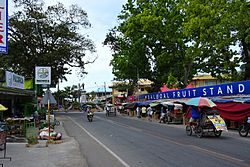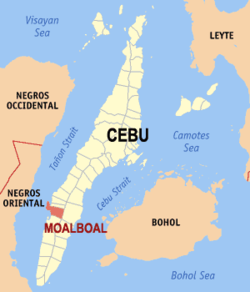Moalboal
| Moalboal | |
|---|---|
| Municipality | |

Poblacion (town centre)
|
|
 Map of Cebu with Moalboal highlighted |
|
| Location within the Philippines | |
| Coordinates: 9°57′N 123°24′E / 9.95°N 123.4°ECoordinates: 9°57′N 123°24′E / 9.95°N 123.4°E | |
| Country | Philippines |
| Region | Central Visayas (Region VII) |
| Province | Cebu |
| District | 2nd district of Cebu |
| Founded | 6 February 1852 |
| Barangay |
15 (see § Barangays)
|
| Government | |
| • Type | Sangguniang Bayan |
| • Mayor | Inocentes Cabaron (1‑Cebu) |
| • Vice mayor | Lingling Rozgoni |
| • Town Council |
Members
|
| • Representative | Peter John Calderon |
| Area | |
| • Total | 124.86 km2 (48.21 sq mi) |
| Population (2015 census) | |
| • Total | 31,130 |
| • Density | 250/km2 (650/sq mi) |
| • Voter (2016) | 19,821 |
| Demonym(s) | Moalboalanon |
| Time zone | PHT (UTC+8) |
| ZIP code | 6032 |
| IDD : area code | +63 (0)32 |
| Income class | 4th class |
| PSGC | 072233000 |
| Website | www |
Moalboal is a 4th municipal income class municipality in the province of Cebu, Philippines. According to the 2015 census, it has a population of 31,130. In the 2016 electoral roll, it had 19,821 registered voters.
Extending as a peninsula on the south-western tip of Cebu, Moalboal is bordered to the west by the Tañon Strait. Negros Island can be seen from the western shoreline. Moalboal is between the towns of Alcantara and Badian, located 89 kilometres (55 mi) from Cebu City, about 2½ hours by bus.
Pescador Island, a popular tourist attraction, is part of the municipality.
Moalboal comprises 15 barangays:
In the 2016 electoral roll, it had 19,821 registered voters, meaning that 64% of the population are aged 18 and over.
Though the majority of the people in Moalboal are Cebuanos, a few members of cultural minorities have found their way there. Bajaus who are similar to Muslim nomads, are often seen in the streets, especially during the holiday season, as some of them make their living by begging. There is no evidence though that the badjaos have taken up permanent residence in the town.
Moalboal is a peninsula and therefore it is almost entirely surrounded by water. Majority of the people who live in the flat lands engage in fishing as their main mode of livelihood. Those who live in the mountain regions, like Agbalanga and Bala, live through farming.
The common mode of transportation is by motorcycles with side cars, known locally as pedicabs or, depending on the distance, tricycles with side cars, called trisikads.
Since the 1970s, Moalboal has developed a tourism industry based on recreational diving and beaches. Panagsama Beach is where most resorts and restaurants are established. Further north on the peninsula, in Saavedra, is White Beach (Basdako), a two-kilometre (1.2 mi) beach which still has sand. This beach used to be quieter and mostly frequented by locals, but has only recently developed a tourist trade.
...
Wikipedia

